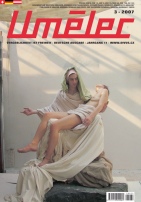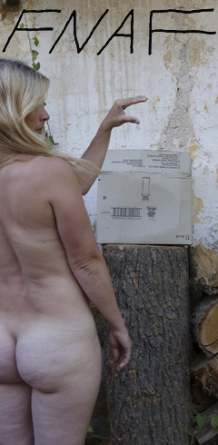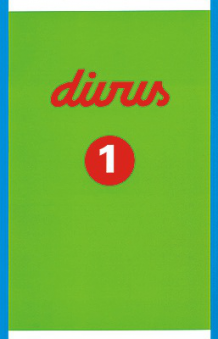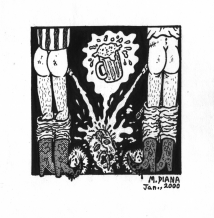| Umělec magazine 2007/3 >> Coming out the Czecho(slovak) way | List of all editions. | ||||||||||||
|
|||||||||||||
Coming out the Czecho(slovak) wayUmělec magazine 2007/301.03.2007 Zuzana Štefková | theory | en cs de es |
|||||||||||||
|
"It’s depraved to believe in some sort of instincts," says an elderly man with a bloodied face in French to a younger man, who just a short distance from him is crawling across the garden and apparently dying. “To stick your dick into a stinking pussy, a hole, from which blood flows … after fucking pussy, your dick falls off,” the man adds without raising his voice; immediately thereafter he continues with an unusual confession: “The tenderness that you carry within yourself cannot be disguised with machismo.” This is more or less how a scene from a video by Mark Ther entitled I’ll Get You Out and Chop You Up Midair (2007) plays out. The video was shown at this year’s Praguebienale 3. Considering that, until recently, art created for the mainstream Czech viewer by Czech homosexual artists tended only to hint at homoeroticism or even avoid homosexual topics whatsoever, videos like this one could possibly pave the way for a much more definite coming out.
Gay and lesbian artists have three options for how to reconcile their sexuality to the fact that they produce visual art. In the first case, they hide their sexuality and their work thus does not give any obvious indication of their deviation from the heterosexual norm. The second group does not hide their homosexuality in their private lives; however, they make no attempt to address their sexuality in their work. The third type of artist shows their cards in both their private life as well as in their creative process. This case is, however, the exception not the rule in Czech and Slovak societies. Therefore, the following essay is devoted to that latter group. Due to continued discrimination and the tradition to pathologize homosexuality (this changed in the former Czechoslovakia only with the fall of Communism), it is not surprising that artistic works addressing homosexual desire are produced in a coded language comprehensible only to those in the know. However, in most cases, the viewer does not have necessary information and thus can easily overlook one or more visible indicators. For example, one can look at an older film by the aforementioned Mark Ther, What Gave Me America (1999). In the film the author lies in bed, wearing a wig, with his lips painted red, his face covered in make up and a string of pearls around his neck. The bed is made with “American“ sheets and bed covers and the man rubs himself in a fetishistic manner, while wearing leather gloves. The work is a personal respect paid to Andy Warhol and Maria Callas, whose pictures the author has glued to the soles of his boots. He also pays homage to Nina Simone, whose music he uses as the accompaniment to his film – the song, Ne Me Quitte pas, originally sung by Jacques Brel. The faces in the pictures represent the key to answering the question in the work’s title. However, for the viewer, they are more or less unidentifiable, and so he or she misses the chance to assume the identity of Maria Callas, whose image is evoked by the necklace, the wig and the make up. Just as they miss the allusion to Warhol’s experiments in “crossdressing” gender identity. Playing upon gender identity remains, however, the leitmotif of the entire film and relates specifically to its soundtrack, i.e. the exchange of Jacque Brel‘s voice for that of Nina Simone. The work of Slovak artist, Radim Labuda, who lives in the Czech Republic, is similarly suggestive. In his film entitled Somebody (2003) the camera follows two faces, or rather mouths, which are fighting each other for a gob of honey. The image is cropped such that the genders of both protagonists are not clear. However, the majority of viewers, based merely on personal experience, assume almost automatically that the shot is of a heterosexual couple, even though, in the end, the pair is made up of two men. The film’s sound track enhances this ambivalence by using the Depeche Mode song of the same name as the film. The song was written by a homosexual member of the band, Martin Gore, whose text the director, Labuda, adapted by replacing the female pronoun “she” with its male counterpart. This switch is however almost inaudible, specifically to the Czech viewer, even though it does in a significant way round out the sense or intent of the film. By using the song, accompanied by the images of the same-sex couple, Labuda in a sense expresses the true meaning of the song’s lyrics, while at the same time commenting on the invisibility of homosexual desire in mainstream culture. By elegantly navigating the waves between visual and acoustic legibility, he says something at the same time about his own reluctance to unequivocally connect his own amorous desire as part of his artistic work. One of the first gays, who, on the contrary, used the male physique and feelings between men as the main inspiration for his work, is Slovak photographer, Peter Janáčík. The catalogue for his Fata Morgana exhibit includes photographs of young men, in many cases almost boys, next to photos of abandoned objects and TV screen shots that capture men in aroused or erotically-toned situations. Janáčík’s portraits of torsos draw on the tradition of standard black and white male nude and portrait photography. But in contrast to such traditional photos, his pictures evoke the vulnerability of his models, their nudity, and melancholic wistfulness. The pre-shot photos of TV images, for example Passion II (2000), represent a less traditional approach. These pictures express the theme of physical connections between men, which cannot be limited only to erotic attraction. Without their accompanying story, Janáčík’s isolated images become iconic pictures of consonance, ecstasy and suffering. The vulnerable positions of Janáčík’s models find their origins in the tradition of the homosexual nude, or better stated, in that of nudes that generally attract the attention of the homosexual community. Specifically, the shoulders lifted prone behind the head in the picture entitled Mille de fleures (2001) bring to mind St. Sebastian, who thanks to his beauty and his suffering became a favourite of the gay public. The saintly impotence and nudity have both touched and aroused generations of gays, while the arrows that cause suffering and religious ecstasy, bring to the informed public’s mind the ideas of suffering and passion associated with a desire for the same sex. Radim Labuda’s film, Push the Button (2006), also draws on associations to the fascination with martyrdom, even if, in this case, it is done in a rather ironic context. The film includes an image of a man in a tuxedo sensually caressing a swarthy male torso that is wrapped in a belt loaded with explosives. "The button" mentioned in the film’s title references a scene, where an invisible man (the role is played by the author himself) plays with the nipples of a "terrorist." This film touches all at one time upon several political and erotic taboos. Most provocative is the presentation of the terrorist’s body in a (homo)erotic context. This is both problematic for opponents of suicide bombers as well as for their supporters. While for one group, the erotifying of the fanatic’s body is the unacceptable issue, for the other group the problem arises in the desecration of the idea of martyrdom. The erotic game can function as a political metaphor, in which the caressing hand representing the white, secularly-alligned and open-to-homosexual desire attitude of the Western world is juxtaposed against the easternly swarthy, exotic, naked body of the "martyr," who is determined to destroy himself under the influence of ideals and religious authorities that do not hide their disgust for homosexuality. The new formulation of the relationship "us“ and "them" contains in itself an allusion to the eroticization of the Other, a concept very popular in romantic harem scenes. However, the portrayal is atypical in the fact that the object of desire is masculine. Using an explosive-laden belt, the author begins to flirt with the Other aspect of danger, underscored by the significance of obtaining complete and utter pleasure. The Bataillesque joining of eroticism and death also plays an important role in the film Hanes (2007) by Mark Ther. The camera follows a police commissioner examining the bloody bodies of two young men, around whom a confused little dog wanders aimlessly. From subtitles providing the content of a phone conversation, the viewer finds out that the two men lived together. But he/she can only speculate on the cause of their deaths. Was it a double homocide, or a murder and then subsequent suicide? The bloody underwear, which is examined in detail by the camera lense, suggests a certain aspect of sadism. But rather than relating to Sade, who defined murder as the pinnacle of erotic arousal, Ther’s approach relates to what Bataille called the desire for the continuity of two separate beings. Death, in this case, is what allows this fusion: If the union of two lovers is the result of passion, then it beckons death, a desire to murder or to commit suicide. The aestheticising of the dead body, or corpse, goes hand in hand with eroticization. The blood contrasts with the white underwear and socks. The bedroom, where the dead bodies lie, is immaculate, and all seems to be adapted such that the viewer’s attention is not distracted from the two bodies- objects. The words of Sarah Kent compare the beauty of corpses in the history of art to the principle of how pornographic works function: “The model becomes […] an immortal creation, which the viewer can pyschologically control and fantasize about. The person becomes a puppet, a doll, an object, onto which anyone can project his/her sexual fantasy ..." The body is thus, in such cases, erotic due to the lack of its own will, guaranteeing the viewer a peak at symbolic immunity. Next to these, at first glance rather extreme representations of homoerotic desire, other attempts at contextualizing homosexual orientation "in the first person" have also appeared. During the past several years this has included, for example, the very explicitly erotic photographic moments from the partnership of Mikuláš Rittstein (studying under Vladimír Skrepl at the Prague School of Arts); variations on classic male nudes with the infusion of erotic tension by blending in fashion photography as done by Martin Kámen (a student from the Veronika Bromová studio at the same school); or the harshly ironic homosexual transvestite from the Ostrava musical arts group of pop gays, I love 69 Popgejů, The members of this group are of, in their own words, uncertain sexual orientation. On the other hand, works have been created that elude strictly sexualized or the ostentatiously aestheticized image of homosexual desire. Among isolated works that fall into this category of "normalizing" the image of homosexual relationships are Radim Labuda’s film Martinů Reloaded (2003). In this video two men, one of which is dressed as a businessman and the other is naked, brush their teeth in front of the bathroom mirror. The film is accompanied by the music of Bohuslav Martinů, which creates a strange tension in contrast to the banality of the scene portrayed. In this film Labuda is not underscoring erotic desire, but rather the day-to-day reality of a relationship between two men (played by Labuda and his partner). A scene, which is ironically commented by "inappropriately" dramatic music. In fact, it is this inappropriateness that evokes the question of "normalcy" and its subsequent reevaluation. This last mentioned approach to the problem of homosexual identity, based on making visible the mundane aspects of a partnership between two gay men, paves the path for possible developments and reflection upon this topic. Czech gay artists, including those mentioned in this essay, often emphasize their dislike of labels and one-sided interpretation of their works. In this regard “mundane" but also any other possible visualization of homosexual relationships that addresses prevailing clichés appear to be a possible means of breaking down societal prejudices. At the same time they can help to overcome stereotypes concerning the interpretation of artistic works based merely on the artist’s sexual orientation. In other words: once the depiction of homosexual desire is perceived as innocuous to the same extent as that of heterosexual desire in contemporary society, then people will cease to have a selective approach, as mentioned in this text, laden with a taste of stigmatization. We can only imagine what different types of visualizing homosexual desire will evolve. However, for the time being, it is clear that a few pages of text will not suffice to bring about this change.
01.03.2007
Recommended articles
|
|||||||||||||
|
04.02.2020 10:17
Letošní 50. ročník Art Basel přilákal celkem 93 000 návštěvníků a sběratelů z 80 zemí světa. 290 prémiových galerií představilo umělecká díla od počátku 20. století až po současnost. Hlavní sektor přehlídky, tradičně v prvním patře výstavního prostoru, představil 232 předních galerií z celého světa nabízející umění nejvyšší kvality. Veletrh ukázal vzestupný trend prodeje prostřednictvím galerií jak soukromým sbírkám, tak i institucím. Kromě hlavního veletrhu stály za návštěvu i ty přidružené: Volta, Liste a Photo Basel, k tomu doprovodné programy a výstavy v místních institucích, které kvalitou daleko přesahují hranice města tj. Kunsthalle Basel, Kunstmuseum, Tinguely muzeum nebo Fondation Beyeler.
|


































 We Are Rising National Gallery For You! Go to Kyjov by Krásná Lípa no.37.
We Are Rising National Gallery For You! Go to Kyjov by Krásná Lípa no.37.
Comments
There are currently no comments.Add new comment